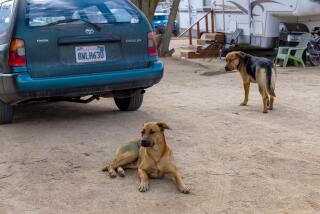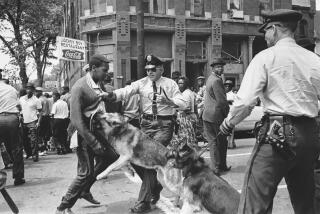Dogged Pursuit : Bloodhounds Take Bite Out of Crime in Orange County
- Share via
Orange County Sheriff’s Reserve Sgt. Larry Harris likes to talk about the accomplishments of his tactical investigative unit--how his deputies are often called to crime scenes when other investigators have given up and the only clues are microscopic flakes of dead skin.
“They’re a special breed of crime fighters,” he says proudly.
They are Duke, Duchess and Sable: deputized bloodhounds.
Used mostly till now in rural areas of the Midwest, South and East, this specially trained dog with its well-endowed nose is catching on as a law enforcement tool in Orange County.
During the last few months, a murder suspect was hunted down by the dogs using a glove left at the scene of the crime, a suspected car thief was found through a single footprint left in the dirt, and a missing 74-year-old man with Alzheimer’s disease was found after a bloodhound took a whiff of his pajama top.
Harris recalls one night when his dogs sniffed out a pedestrian’s severed leg that had been thrown 270 feet from the point of impact after an accident involving a drunk driver.
Gary Bale, a Sheriff’s Department homicide investigator, said he has been calling the bloodhounds to crime scenes with increasing frequency.
“The bloodhounds are a real good tool, way under-utilized,” Bale said. The dogs, he said, have helped officers retrieve evidence that otherwise would never have been found.
“Just a couple of months ago, we followed a dog trailing the path of a murder suspect and found a gun he discarded along the way. . . . It’s unlikely we would have found the murder weapon if we didn’t have the dogs to lead us in the right direction.”
The abilities of these black-and-tan or reddish dogs with the long, doleful faces have been well-chronicled.
The bloodhound is one of the oldest hound breeds and is believed to have originated in Egypt. The dog was brought to Europe before the Crusades and was a favorite pet of the nobility.
With noses many times more sensitive than those of humans, bloodhounds were used extensively during the mid-1800s in the South to track criminals and escaped slaves.
But for years they were not considered an effective law enforcement tool in urban areas because scents are more difficult to pick up. Dog trainers, however, say that was largely a reflection of training methods and not the keen smelling and tracking abilities of the dog.
With improved training techniques, bloodhounds are being taught to track scents on water as a way to lead searchers to drowning victims. They are also being trained to find bodies by recognizing the scent of decomposing human tissue.
One of the most valuable uses of the dogs has been in search and rescue operations.
“We’re only beginning to scratch the surface of what these dogs can do,” said William Tolhurst, president of the North American Search Dog Network, who has trained bloodhounds for more than 30 years in Lockport, N.Y.
“There isn’t a nose in the business like the bloodhound’s. It’s the Cadillac of noses,” he said.
“Interest in the use of bloodhounds by police agencies has really increased in the West and particularly in Southern California the past few years,” Tolhurst said.
As of last month, Harris’ dogs had been called to 28 investigations in the county, compared to the 36 times they were used during all of 1989.
“The word is getting out. A lot of agencies are just beginning to see the things we can do,” Harris said.
Tolhurst and others in law enforcement attribute the emergence of bloodhounds in police work in Southern California to trainers like Harris, who volunteer their time to properly train the dogs.
Harris, 61, took over the Sheriff’s Department’s bloodhound unit in 1986. At that time, the 15-year-old program had three dogs that were rarely used. Harris and Reserve Deputy Gary Altheide found good homes for the old dogs and revitalized the program with new bloodhound puppies that Harris personally trained.
With the recent success of Harris’ dogs, police departments throughout the county have called for the unit’s services on everything from missing children to fleeing murder suspects. Harris was also instrumental in helping the Costa Mesa Police Department develop its bloodhound unit.
A retired engineer from McDonnell Douglas, Harris has been a reserve law enforcement officer for 30 years. He is in good physical shape, in part because he often has to run at a full sprint when one of his dogs gets the whiff of a strong scent and takes off.
The hunt begins when Harris straps the harness and a 15-foot leash on a dog and gives it a “scent article”--any object that is saturated with a person’s “scurf,” or dead skin cells.
“Body scurf is loaded with bacteria on it, and it becomes as individual as a fingerprint to a bloodhound,” said Harris, noting that a person sheds about 50 million skin cells a day.
While trailing, a bloodhound uses its long, loose, floppy ears and skin to flip up the scurf for a better smell. They also drool to enrich the scent before it goes into their nose. The bloodhounds are “single-minded” and follow only the trail of a person they are after, Harris said.
Experts say bloodhounds are often able to smell a trail as old as seven days and are the only true man-trailers. Other breeds, however, like Labradors, malinois and German shepherds, have been useful in other areas of police work, such as drugs, explosives and patrol.
There are drawbacks to using bloodhounds in urban areas, however. Heavy concentrations of vehicle exhaust and chemical fumes can kill a scent, and many times trails will abruptly end when a suspect simply gets in a car and drives away.
By far the biggest obstacle to any trailing, Harris said, is finding a good scent article.
“A lot of times an officer will pick up a scent article, put it in his pocket and then give it to us,” Harris said. “After that, it’s been contaminated and complicates the job.”
But when given a good scent article and a fresh trail, Harris’ bloodhounds are tough to beat--especially at their cost to the county.
Harris and his team, which includes his wife, Jean, fellow dog handler Gary Altheide and backup Deputies Jack Denny, Ernie Ngayan, Bill Lakow and Matt Johnson, all members of the sheriff’s search-and-rescue reserve unit, volunteer their time and services.
The county reimburses the unit for veterinary bills, dog food and gas mileage from scene to scene. Recently, the county provided the team with a van.
After more than 200 hours of call-outs and 1,700 hours of training time in 1989, Harris says he can’t get enough of it. “I really enjoy this program. . . . If we can save one life or find one child or help one little elderly lady get back to her home, well, that’s what makes it all worthwhile.”
More to Read
Sign up for Essential California
The most important California stories and recommendations in your inbox every morning.
You may occasionally receive promotional content from the Los Angeles Times.













